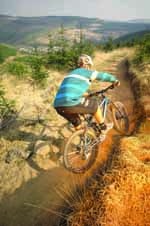 SUSPENSION
SUSPENSION
Kona calls its suspension design a four-bar, and while there are four elements in the linkage, it is better described as a low single pivot with a linkage-actuated shock. Two holes in the lower shock mount allow you to choose how progressive the Dawg’s suspension is. In reality, repositioning the shock doesn’t actually make that much difference as the air spring has already started to ramp up a lot. The mounting position furthest from the seat tube does, however, drop the bottom bracket by approx 2mm. And while this is really undetectable, we’ll take whatever we can get on a bike with a 14.25in bottom bracket height. To further reel in the lofty BB we also ran slightly more sag than normal. This reduces available travel and rakes the fork out more, but overall it makes the Dawg handle better.
For climbing you really need to use the ProPedal setting on the Fox RP2 shock to increase the low-speed compression damping, which reduces pedal-induced bob. It’s worth noting that the positive ProPedal setting also props the rider up more in the initial part of the stroke so you should always set the spring rate and corresponding sag with the minimum ProPedal.
Every time we ride the basic Fox 32Float R fork we come away more convinced that it is one of the best trail forks on the market. You set the spring rate, dial in the rebound and you are up and running. You really don’t need all of those extra bells and whistles.
COMPONENTS
Everyone commented on how the WTB Lazer V Race saddle looked out of place on the Kona. It’s not that it is uncomfortable, it’s just that the profile is more akin to that found on a commuter bike or, dare we say it, a women’s bike. While the Race Face finishing kit is solid and reliable and it is great to see a 26in-wide handlebar, we would have liked a couple of extra headset spacers for a wider range of stem height adjustment.
Hayes HFX 9 brakes aren’t the latest must-have brakes, but the 6in rotors front and back provide more than enough stopping power for UK riding. Also, if you plan on taking the Dawg to the Alps, the HFX-9s won’t pump up or spill their guts all over your rotors.
PERFORMANCE
Being the cheapest bike on test the Dawg Primo was always going to be at a slight disadvantage, but while it’s 20 per cent heavier than the Specialized or Trek it does leave you with £600 to £700 in your pocket to spend.
At 14.25in the Dawg has easily the highest bottom bracket on test. One of the problems with such a high bottom bracket is that you feel perched on the bike rather than in it. This is because, for a given leg extension, your saddle will always have to be higher than a bike with a lower bottom bracket. As a result, your centre of gravity is higher and you also need to raise your handlebar to match. Obviously pedal and chainring clearance isn’t an issue, but we struggled with the bum-in-the-air feeling that the high bottom bracket gives. Thankfully the Kona also has the longest wheelbase on test and a pretty slack head angle, both of which stop the Dawg riding like a rollerskate.
Suspension performance on the Kona feels similar to the Trek, and it shares its need for a ProPedal lever when climbing. It is, however, a stiffer frame and will take more of a beating than the Trek.
VERDICT
The Kona Dawg Primo is a solid platform on which to upgrade. Just get the dealer to swap the Maxxis 2.35in Ignitor tyres before you leave the shop. The Ignitors are not the best all-round performers and swapping to 2.1in tyres will drop the BB height by half an inch to an acceptable 13.75in.
MBR RATING: 8/10



